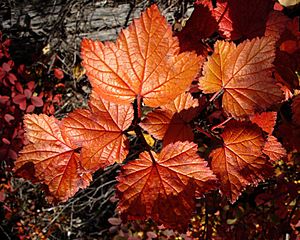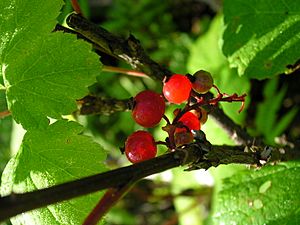Ribes triste facts for kids
Quick facts for kids Ribes triste |
|
|---|---|
 |
|
 |
|
| Scientific classification | |
| Genus: |
Ribes
|
| Species: |
triste
|
| Synonyms | |
|
|
The Ribes triste, often called the northern redcurrant, swamp redcurrant, or wild redcurrant, is a type of shrub. It is part of the gooseberry family. This plant grows widely across Canada and the northern United States. You can also find it in eastern Asia, including Russia, China, Korea, and Japan.
This plant likes to grow in wet, rocky places, swamps, and on cliffs. It can reach about 50 centimeters (20 inches) tall. Its branches often spread out or creep along the ground. The leaves grow alternately on the stem. They have five main sections, like fingers on a hand, and are about 6 to 10 centimeters (2.4 to 3.9 inches) wide.
The flowers grow in hanging clusters called racemes. These clusters are about 4 to 7 centimeters (1.6 to 2.8 inches) long. Each cluster has 6 to 13 small, purplish flowers. They usually appear in June and July. The fruit is a bright red berry. Unlike some other currants, these berries do not have hairs. They are safe to eat but taste quite sour.
Contents
Protecting the Northern Redcurrant
In the United States, the northern redcurrant is protected in some states. It is listed as endangered in Connecticut and Ohio. This means it is at high risk of disappearing from these areas. It is also listed as threatened in Pennsylvania. This means it could become endangered soon if not protected.
Is the Northern Redcurrant a Pest?
Sometimes, the Ribes plant, which includes the northern redcurrant, can be seen as a plant pest. In Michigan, for example, planting it is not allowed in certain areas. This is often because Ribes plants can carry diseases that harm other important plants, like pine trees.
Traditional Uses by Native Americans
Native American communities have used the northern redcurrant for many years. They used it for food and for traditional health practices.
Northern Redcurrant in Traditional Food
Many Native American groups used the berries as food.
- Alaska Natives ate the fruit fresh. They also made the berries into jams and jellies.
- Eskimos ate the berries.
- The Inupiat ate them raw or cooked. They mixed them with other berries to make a traditional dessert. They also boiled the berries with rosehips and highbush cranberries to make a syrup.
- The Iroquois mashed the fruit and made small cakes. They stored these cakes for later use. When ready to eat, they soaked the cakes in warm water and cooked them as a sauce. They also mixed them with corn bread. The Iroquois also dried the fruit in the sun or over a fire. They took this dried fruit with them as food when hunting.
- The Ojibwe ate the berries fresh. They also cooked them and spread them on birch bark to make small cakes. These cakes were dried and stored for winter. In winter, they often ate the berries cooked with sweet corn. They also used the berries to make jams and preserves.
- The Upper Tanana people also ate the berries as food.
Northern Redcurrant in Traditional Medicine
Some Native American groups used parts of the plant for traditional health remedies.
- The Ojibwe made a special liquid from the root and stalk. They used this for issues like kidney stones. They also used a mix from the stalk for certain women's health concerns. The leaves were also used as a general remedy for women.
- The Upper Tanana people made a liquid from the stems (without the bark). They used this liquid to wash and soothe sore eyes.

